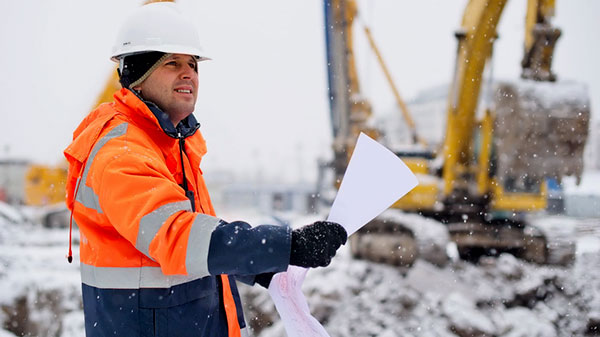
Special considerations are needed to protect workers from winter conditions.
Construction doesn’t take a break in the winter. If you manage a construction site, think about the additional hazards of the season and take the appropriate safety precautions.
Cold temperatures, wet and snowy weather and wind chill can take a harsh toll on the human body. Increase your knowledge and awareness of cold weather issues such as frostbite and hypothermia.
Pay special attention during the winter months at your construction site to avoid safety hazards.
- Know the signs of winter-related injuries and illness. Educate your workers and supervisors about these cold-related injuries and illnesses and their warning signs and symptoms. For instance, shivering, lack of coordination and slurred speech are symptoms of hypothermia. If a worker exhibits any signs of illness or injury, call emergency help immediately. The Occupational Safety and Health Administration provides a Cold Stress Card that describes how to prevent and treat these serious illnesses.
- Require workers to wear the proper clothing and gear. Clothing and gear should be based on the temperature, weather conditions and duration of activity. Workers should wear layers whenever necessary, including an insulating, moisture-wicking base layer and a waterproof outer layer. Workers also should wear insulated, waterproof boots with extreme traction as well as warm socks and hats and gloves with grips to handle equipment safely.
- Discourage workers from drinking coffee or other caffeinated beverages. Many construction workers work overnight and turn to drinks with caffeine to help them get through their shift. However, drinking caffeinated beverages in winter can increase workers’ heart rates, making them feel falsely warm. Instead, encourage workers to drink water to stay hydrated.
- Remove ice and snow before starting work. Construction workers have enough conditions causing danger at the worksite; they don’t need to add ice and snow to the mix. Make sure all ice and snow has been removed and salt or sand has been put down on any large patches of ice before starting work. It may seem like a time-consuming task, but it will protect everybody on the job site.
- Provide a warm break area. Outside work is necessary for the construction industry, but workers need a place to take a break from the elements and warm themselves. It can be a heated trailer or a tent with portable heaters. Employers also should be sure supervisors and workers follow proper safety procedures with heating devices.
Construction workers have a dangerous job, especially during the winter. Make sure your crew is properly prepared for the extreme temperatures, snow and ice this winter. For more information and guidance on this topic, please review the resources from OSHA and CPWR, The Center for Construction Research and Training.
This loss control information is advisory only. The author assumes no responsibility for management or control of loss control activities. Not all exposures are identified in this article.
